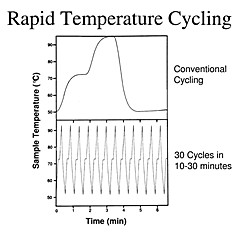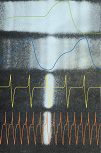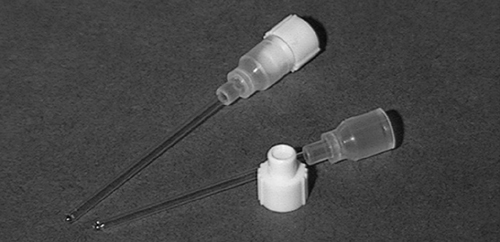Faster is Better
When PCR is performed rapidly, the quality of PCR products is often better. Back in 1990, we were amplyfing PCR products of 500 bp in about 15 min. This was accomplished by using little or no holds at extension, denaturation or annealing temperatures. Advancement in instrumentation and technology now allows even faster PCR.
Figure on the right shows a gel image of PCR products overlaid with temperature traces from the amplification that generated each of the products - more specific product is generated with faster PCR. (Click image to enlarge)
Speed is Limited by Instrumentation, not by Biochemistry
In order to perform rapid PCR, we had to build instruments that cycled temperatures fast, yet had very good control over the actual temperature of the sample. We decided to use hot and cold air to drive temperature transitions, and glass capillaries as sample containers for rapid heat transfer and dissipation.
The thermocouple in the reaction chamber was carefully selected so that its thermal response was matched to that of the sample in the capillary. This way, we were able to accurately monitor and control sample temperatures during rapid PCR.
Optimizing Rapid PCR
Many of the protocols and guides for optimizing rapid PCR were described in the
RapidCyclist which is reproduced here with permission (Vol.
1,
2,
3 ). These articles are particularly useful for understanding optimization in the following areas:
- Rapid PCR reagent recipes (for glass capillaries)
- Starting cycling conditions
- Optimizing Mg and annealing temperatures
|

|
Key References
- Original BioTechniques manuscript abstract
- Book chapter: Rapid Thermal Cycling & PCR Kinetics In: PCR Methods Manual. Innis M, Gelfand D, Sninsky J (Eds.), Academic Press, San Diego, 211-229 (1999)
- Book chapter: Rapid Cycle DNA Amplification In K Mullis, F Ferre and R Gibbs (Eds.), The polymerase chain reaction. Springer-Verlag, Deerfield Beach, FL, 174-181 (1994)
Publication Links and Reference List Browse Here !



